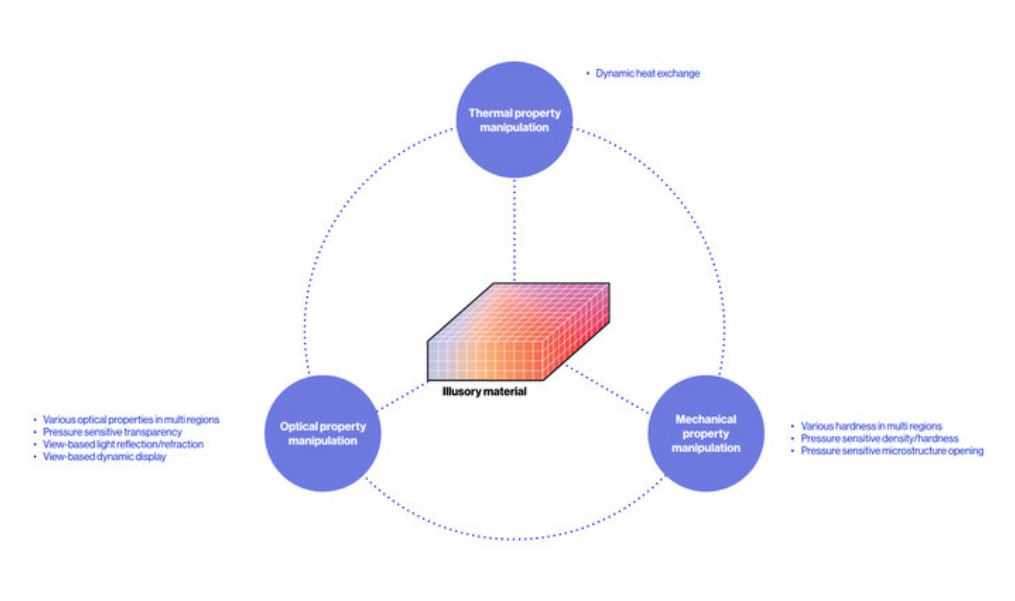China3D printingNet, September 4, award-winning product and industrial designer Zini has been committed to creating a practical and responsive consumer experience through design that combines elements of the physical and digital world.Her work explores emerging technologies (e.g. AI, IoT, multi-material3D printing) New design ideas and material possibilities brought by.
Her latest work “Optical Textiles” won the “Red Dot: Best Choice” in 2020Awards, The award is selected from 4170 entries from 52 countries and regions.This work is based on her work on biconvex lenses3D printingIn the research of technology, she introduces the concept of “phantom material”, which explains how future designers can not only rely on chemical plants to create color, but can combine her methods with3D printingThe lens is used together with simple color blocks to create hue, texture and refractive index that change over time or different viewing angles.
Although lenticular lens printing is not a new concept, its use is limited to two dimensions to create a 3D display effect on a flat surface. It can create animation or action effects, and can also be used to design hidden messages or images that can only be displayed correctly under a specific perspective. It is usually used in novel cards, toys, magnets, displays, etc.With the support of MIT Media Lab and Professor Axel Killian and Professor Stefanie Mueller, Zeng Jian, Deng Honghao and Zhu Yinyi developed a biconvex lens3D printingFrame, which is a three-dimensional design method used by designers to control and create dynamic colors and textures. Their goal is to “overcome the limitations of traditional design, eliminate the need to simply copy existing materials, and create dreamlike material expressions that only exist in the digital world.”
In a sense, although smart materials have been developed before for medicine or footwear, this novel approach is unique, and it attempts to make material creation and design creation closer than ever before, for use in the digital world “Impossible” materials and eliminate surface restrictions in products or industrial designs that use traditional materials.
“Our goal is to criticize the existing design methods and experiments in the digital and physical world; overcome the limitations of traditional design and no longer need to simply copy existing materials; break down the design medium into “problems”, reorganize and reshape Importance to create unique expressions, forms, characteristics and experiences.”
They developed a computational workflow to allow designers to create optical effects on any free-form surface, and then use multiple materials3D printingMachine (the researchers here use the Stratasys J8 series) directly3D printingPhysical materials/objects. The 3D concept prints the material as a lenticular lens to provide visual effects, so that the top and bottom layers have colored or patterned base materials. Visual or functional information is embedded in matter at the voxel level, so it can dynamically respond to changing environments (movement patterns, interactive written messages, or touch-sensitive visual effects), or user intervention without any electrical operations or robotic elements.

Image courtesy of “Fantasy Material” and “Core77 Award”
The voxel printing method can be used by designers who are familiar with CAD modeling and does not require any coding knowledge. This also enables designers to “play CMF” (colors, materials, finishes) with new digital materials, and more importantly, include surface details, textures and refractive index at the beginning of the design process to create dynamic, interactive Functional product. This method will provide product designers, industrial designers or architects and manufacturers with a design platform to digitally build the next generation of physical products.
In order to demonstrate the possibility of “phantom material”, concept products include Nseen (a minimalist perfume bottle with hidden basic information), Loopop (a lollipop with varying color patterns and unique textures), Unream (sculpture lamp) and objects Made of flexible material.

Loopop, Unream and Nseen.Image courtesy of Illusory Materials Core77 Awards
In addition, Zeng and Deng believe that “Illusory Materials” will help advance the design and manufacturing of circular economy, prevent traditional waste and significantly improve the recyclability and sustainability of the product life cycle.As part of the Strategy and Research Award (Core 77 Design Award 2020), the designer pointed out that “if there is a “super material” that can imitate any material characteristics in production, we may solve major issues such as material waste, recycling, and distribution. “Fake material” is essentially everyone’s “one” material. Printer materials (made of resin) can imitate different material properties, color mixing, and any optical effects. Imagine future appearance designs that do not depend on secondary processes Instead of relying on a single printed matter of the same material, imagine that one day, all materials can be displayed on their own without electronic equipment. How much waste can be prevented? Imagine that there is a material that can imitate the characteristics of any material. And can be done in any form3D printing, And can be easily recycled and reused to become the original filament.We believe that using multiple materials3D printingIt will be in the near future. “
Zeng is also (together with Deng) the co-founder and executive director, and launched Butlr Technologies in 2019. The company uses low-cost IoT devices and AI to non-invasively track and analyze people (to detect their body heat instead of Single image or video)) Exercise indoors or outdoors. It only tracks the heat of the human body to protect personal privacy, has great potential in home, retail, travel, care and hospitality environments, and is a particularly relevant solution during the pandemic, which can help retailers and museums use better The tools are reopened to minimize risk.
China3D printingNet compile article!
(Editor in charge: admin)


0 Comments for “MIT researchers develop “imaging materials” and lenticular lens 3D printing platform”